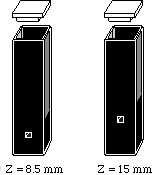
What does Z Dimension mean?
Each instrument manufacturer makes engineering decisions for the design of their instrument to assure that it performs optimally. The height, width, focus and placement of the lightbeam in any instrument is based on the engineering decisions to assure that the instrument performs to their published specifications. It is important to you, as the instrument user, only when you are attempting to use a small sample volume. You must assure that your smaller volume is placed in the center of the light beam and that any light which does not pass through your sample is blocked (or masked) by black material. If the cell is not properly masked then the sensitivity will be eroded.
Z Dimension of various manufacturersWe have compiled this list of Z Dimensions from some of the instrument manufacturers. If you find a discrepancy in this list, please let us know and we will investigate.
| Spectrophotometers | |
|---|---|
| Manufacturer | Z Dimension |
| Agilent® | varies by instrument |
| Beckman® | 8.5 mm |
| Bio-Rad® | 8.5 mm |
| Cecil® | 15 mm |
| Eppendorf® | 8.5 mm |
| GBC® | 15 mm |
| Hewlett Packard® | 15 mm |
| Hitachi® | varies by instrument |
| Jasco® | 12 mm |
| Jenway® | 15 mm |
| Ocean Optics® | 15 mm |
| Perkin-Elmer® | 15 mm |
| Pharmacia® | 15 mm |
| Scinco® | 15 mm |
| Shimadzu® | 15 mm |
| Spectronics® | 8.5 mm |
| StellarNet® | 15 mm |
| Thermo Spectronic® | 8.5mm and 15 mm |
| Turner® | 8.5 mm |
| Varian® | 20 mm |
| Fluorometers | |
| Manufacturer | Z Dimension |
| Hitachi® | varies by instrumentm |
| Horiba® | 15 mm |
| Jasco® | 18 mm |
| Molecular Devices® | 15 mm |
| Ocean Optics® | 15 mm |
| Perkin-Elmer® | 15 mm |
| Pharmacia® | 15 mm |
| PTI (Photon Technology)® | 15 mm |
| Scinco® | 15 mm |
| Shimadzu® | 15 mm |
| SLM Spectronics® | 15 mm |
| Spectra Max® | 15 mm |
| Spex (Horiba)® | 15 mm |
| StellarNet® | 15 mm |
| TSS® | 15 mm |
| Varian® | 20 mm |
How can I determine the Z Dimension of my instrument?
You can test for the Z dimension of your instrument very easily. Simply follow these steps:
- Cut a piece of dense paper 12mm wide and 100mm long.
- Make a hole in the center of the paper about 3mm in diameter (you can just push a ballpoint pen through the paper) 8.5mm from the bottom of one end and 15mm from the bottom of the other end.
- Turn on your spectrophotometer in %T mode and set to any reasonable wavelength.
- Place the piece of paper with the hole in the end into the cell holder as if it were a cell. Whichever end (either 8.5mm or 15mm) transmits light will tell you the Z dimension of your instrument.
- If neither works then make up another piece of paper with holes placed at different dimensions and determine which works best.
